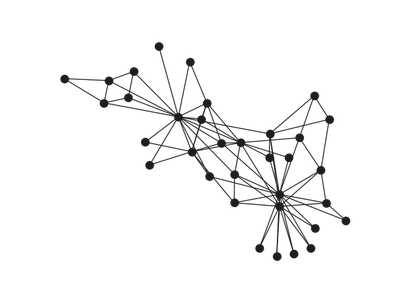CSL7390: Social Network Analysis
Offered in Autumn 2021 Semester

- Credits L-T-P [C]: 3-0-0 [3]
- Expectation from 7000 level course:
- 1 Contact Hr + 3 Non-Contact Hr
- Learn by Research
- Where: Google Meet (Link Available in Moodle)
- Slot: O (Monday 6:00 PM - 7:30 PM, Saturday 12:00 PM - 1:00 PM)
- LMS: Moodle
Syllabus
- SNA Introduction
- Graph Recap: Graph Introduction: Adjacency Matrix, Paths, Connectivity, Incidence Matrix, Distance, Breadth-First-Search, Directed Graph
- Network Measures, Centrality, Strong and Weak Ties, Cliques, Component, Structural Balance
- Network Models: Random Networks, Scale-Free Networks, Barabási-Albert Model, Fuzzy-Granular Social Network, Generating Network Data
- Game Theory and Network Traffic Modeling
- Information Cascade, Epidemic spread modeling,
- Small-World
- Community Detection Problem
- Link Prediction Problem
- Evolving Network and Temporal Network
- Python NetworkX
Learning Materials
Textbook
- Networks, Crowds, and Markets: Reasoning About a Highly Connected World, by David Easley and Jon Kleinberg, (Cambridge University Press - Sep 2010) - Prepublication draft available online. http://www.cs.cornell.edu/home/kleinber/networks-book/
- Network Science, by Albert-Laszlo Barabasi, (Cambridge University Press - August 2016) freely available under the Creative Commons licence. http://www.networksciencebook.com/
- Networks, by Mark Newman, (Oxford University Press, 2nd-edition - Sep 2018)
Reference Books
- Complex and Adaptive Dynamical Systems, by Claudius Gros, (Springer, 4th Edition - 2015).
- The Structure of Complex Networks Theory and Applications, by Ernesto Estrada, (Oxford University Press - Dec 2011).
- Exploratory Social Network Analysis with Pajek, by Wouter de Nooy, Andrej Mrvar, and Vladimir Batagelj, (Cambridge University Press, 3rd Edition - July 2018)
Self Learning Material
Grading Policy
| Interaction | Quizzes (Online/Offline) | Project |
| 5% | 5%+10% | 30% |
| Coding Assignment | Major (Open-book/equivalent) | Major (Online) |
| 10% | 20% | 20% |
Interaction
- Moodle Interactive Video
- Discussion Forum Activity
- Class Questions and Answer
Quizzes (Online/Offline)
- There will be about 4/5 quizzes
- Students in the campus will write in offline mode
- Students not in the campus will write online
- Students are expected to attend at least one offline quiz
- https://www.classmarker.com/ or other similar platform
- Weight of offline and online will be as per the academic guidelines
- Anyone missing offline quiz will be taken an makeup Viva at the end
Coding Assignments
- About one per week
- Preferably with NetworkX in Python
Project
- Report: 25%, Peer-Review: 25%, Presentation: 15%, Project Work: 35%
- Grading will be based on:
- Organization: Applicable to Reports and Presentations
- Clarity: Applicable to Reports/Presentation/Work/Interaction
- Length: Too Short/Too Long will be penalized (report/presentation)
- References: Correct and Comprehensive References
- Correctness: Applicable to Development and Contributory Work
- Significance/Coverage: Significance for Contributory Work, Coverage for Survey/Review
- Originality: Plagiarized Content of any form (textual, formulation, images, results) will mark zero for the project component.
- Contribution: Quality of Contribution
- Consideration for A* Grade: Paper submission to above average conference (at least)
Project will be in groups. Size of the group will be decided after add/drop, i.e., Around August 15, 2021.
Important Dates:
- 23/Aug: Last date of group identification
- 31/Aug: Last date for Topic identification
- 01/Sep: 2 Slide Presentation on Motivation
- 06/Sep: ^^ if necessary
- 13/Oct: Abstract Submission
- 31/Oct: Report Submission
- 01/Nov - 10/Nov: Peer Review
- 17/Nov: Revision Submission
- Presentation dates will be announced (tentative: Nov 1, 6, 8, 13)
- Video Presentation if 30+ project is there (dates will be announced)
Plagiarism tolerance is 7% from single source and 15% cumulative, anything more will reduce your marks as follows:
- Any logical/conceptual/formulation plagiarism: zero marks
- Other form of plagiarism (above 50%): zero marks
- Otherwise: Percentage of plagiarism will be deducted from the obtained mark